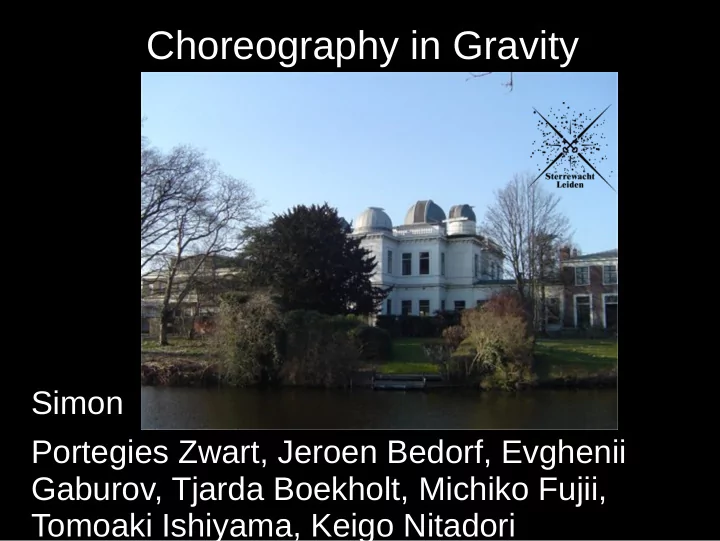

Choreography in Gravity Simon Portegies Zwart, Jeroen Bedorf, Evghenii Gaburov, Tjarda Boekholt, Michiko Fujii, Tomoaki Ishiyama, Keigo Nitadori
An ape on the shoulders of a giant, still is an ape.
Larger comuters require more complex software. But does this lead to a better understanding? ● More scales leads to more complexity ● More physics leads to more complexity ● More complexity leads to less understanding
Therefore Bonsai Small & resilient
Leiden LGM 400GPUs=0.5PFflops Tsukuba 4GPUs = 0.005PFlops 40 GPUs=0.05PFlops CSCS Piz Daint 4000GPUs=5PFflops ~20000GPUs= 25PFflops ORNL Titan
HPC on Titan's GPU-farm
2 × 8 years × 100 steps × 60 operations 10 years 10 11 Stars 10 2.5 × 10
Jeroen Bédorf etal: simulation of Andromeda/Milky Way encounter on Titan
Bonsai simulation Hoag's object (HST)
Being able to perform large calculations is not the same as being able to perform accurate calculations ● “ Errors in calculations of n-body systems grow exponentially … and may therefore invalidate the results ... ” (Miller 1964)
BRUTUS a brute force arbitrary-precision N-body code ● Two ingredients: ● Gragg-Bulirsch-Stoer method – Modified midpoint method – Richardson extrapolation – Tolerance parameter ● Arbitrary-Precision arithmetic – Number of significant digits Tjarda Boekholt 12
Red: dE/E <10 -74 Black: dE/E <10 -11
Exponential divergence δ = 0.5 log 10 1/(6N) ∑ (x 2 -x 1 ) 2 + (v 2 -v 1 ) 2 14
10,000 realizations of N=3 give no systematic bias 15
Conclusions ● While computers get bigger software gets more complex ● Continuing trend in more demanding simulations ● By keeping codes small and dedicated one gains flexibility, strength and tunable performance 16
Recommend
More recommend